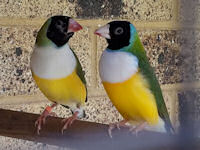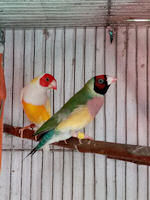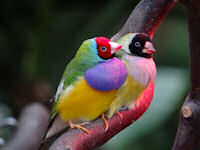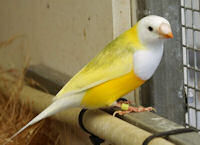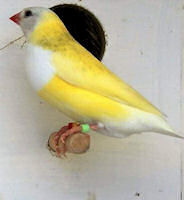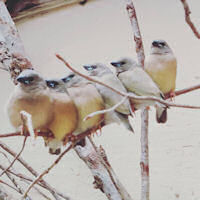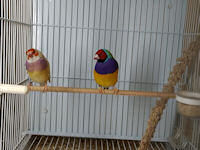Gender
All birds including the gouldian finch are categorized into three distinct groups, 1. Monomorphic. 2. Dimorphic. 3. Polymorphic respectively. You may or may not have heard of these terms before, but they are not as complicated as they sound. Some species are both Dimorphic and Polymorphic. Below explains each one.
Dimorphic
The meaning of the word 'Di' means two or double, and the word 'Morphic' or 'Morphism' means a specific object or a shape. Together 'Dimorphic' means two shapes but within a specific group.
This means that there is a visual or noticeable difference between male and female of the same species. For instance, the male gouldian has much brighter more apparent colours whereas the females have a more dull or less vibrant colours. When you stand a female and male side by side, you will notice the difference in colour tone, making them a dimorphic species. The gouldian finch fits into two categories which are 'Dimorphic' and 'Polymorphic' where polymorphic is explained below.
Monomorphic
The meaning of the word 'Mono' means single, one or by itself, and the word 'Morphic' or 'Morphism' means a specific object or a shape. Together 'MonoMorphic' means a single shape but within a specific group.
When a particular species have little or no difference visually to identify the males from the females, they are a monomorphic species. A monomorphic species can not be identified by weight, colour, markings, size etc and both sexes look almost identical they are known as a monomorphic species. Gouldian finches are not monomorphic. When you think of the word 'Mono' you may think of the word monochrome, and you are correct, but gouldian finches produce three types of gouldian, one with a red head, one with an orange (genetically yellow) head and one with a black head which is more than one colour. If for instance every gouldian had identical colours, shades and patterns with their offspring being the same and so forth then they would be classed as colour monomorphic.
Polymorphic
Firstly, the word 'Poly' means more than one or numerous and the word 'Morphic' or 'Morphism' means a specific object or a shape. Together 'Polymorphic' means two or more shapes but within a specific group. This is a little complicated to explain, so I will do my best to explain as I know it. Using the gouldian finch as an example, the gouldian finch has more than two recurring traits within its own species. There are three head colours throughout their population, Black, Red, Orange (which is actually genetically yellow not orange). This colour is genetic and will reoccur over and over again within its species, and is the same for the Orange and Red. Although there is genetically one group of gouldian finches, there are three differences within that group, and it is this which makes them colour polymorphic.
There are only about 300 species of birds in the world which are classed as 'Polymorphic' out of about 10,000 species.
An example of non polymorphism we could use a Robin, they have a red breast, but this is repeated throughout their entire species because they produce no other colour other than red.
Let us pretend robins began to produce young, some with orange breasts, some with green breasts and some with red breasts. Now, let us also pretend that the offspring with the green breasts began to have green breasted offspring of their own. When those new offspring had their own offspring they also had green breasts, then it would appear that a genetic trait may have occurred. If the same trait happened with the Orange breasted Robins and the Red breasted Robins, then the robin species would become a polymorphic species. Polymorphic is not isolated to colour alone and can refer to shape, size, temperament, markings etc. It is not easy to explain polymorphism, although I do understand it myself, so I hope the above made some sense.
Monomorphic just means that the male and female are almost identical visually, it is hard to distinguish them apart. Dimorphic means the opposite, where you can visually identify the boys from the girls, such as one having more colours than the other or particular markings etc. In some cases with monomorphic species some breeders believe they can determine the gender by using a magnet as a pendulum and hovering it over the bird, depending on its movement it would determine the sex of the bird but in reality you are better off tossing a coin. Birds are not magnetic and there is no proof that this works at all, it is just guessing at its best.
The gouldian finch is dimorphic because you can tell visually the male from the female by the tone of their colours. Males have a more vibrant and brighter (or stronger if you like) colours. Their physical size, overall shape or markings really mean nothing at all. I have heard many strange ways people try to identify the male from the female over the years, and almost all of them were wrong. They can be tested using DNA, by the vent area, by the male singing or by their colours. Female gouldian finches seem to be dull. Although you may have a female and male which have the same colours, side by side you can see the true difference. Only the male will sing, whilst the female can make various short sounds. The sounds the hen makes are not a true song, unlike the males, which sing for much longer lengths of time.
There are gouldian finches which are white all over and albino with red eyes, but even these will have a difference in tone to their white colour. If you are tone blind meaning if you are unable to distinguish different shades of the same colour then maybe the help of someone who is not coloured blind may assist you. I have found with all white or albino gouldians the shade is only slight, so you may need a good eye to spot the difference. They are much easier to identify when stood side by side under good light. When you become more experienced you will be able to identify the males from females just by listening to them, hens make a lot of sounds that the males never make. When you become very professional with gouldians you may start to notice the patterns with their calls, such as noticing they make particular sounds when performing certain actions.
It is believed that the gender of a chick can be determined by the parents during incubation. It is all controlled by how much heat they generate during the incubation process, which allows them to balance the gender ratio among their flock. I personally have never tried to test this theory, but my flock does always seem to have a near even ratio of boys to girls. If one year there are too many adult males, then they seem to produce more hen chicks than males and vice-versa. I have always put it down to coincidence, but maybe there is some truth in it after all.
I just wanted to make a point concerning the hens, during their breeding season you may notice some hens dancing by making a light chirping sound and hopping up and down on the same spot to their partner, this is common and normal. Hens sometimes do this to encourage the males to sing and dance back. You will notice the hen's tail feathers will point towards the male, and the male will do the same to show each other the partner selection has been made.
